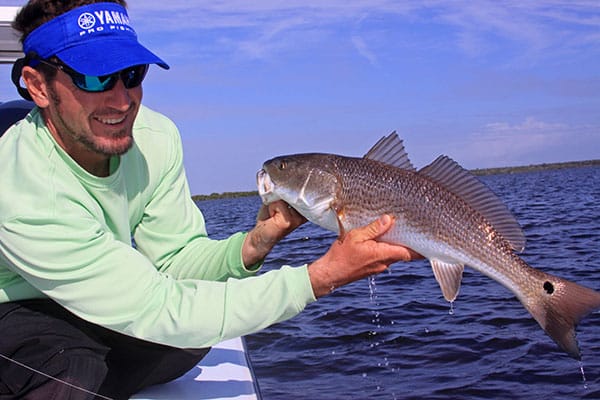
With heads like football helmets and hunter instincts, redfish remain a favorite among inshore anglers. They often travel in pods, creating wakes that announce their presence, and attack with bulldog abandon. When you’re hooked up, straddle in and ride it out, because these bulls put up a fight. A basic understanding of their biology, habitat and their weakness for certain baits and lures will help bring your redfishing game to another level.
Redfish (Sciaenops ocellatus), also known as red drum, sport the trademark “eyespot” at the base of the tail, sometimes several of them. The most popular theory for the presence of these spots is they serve as a decoy, fooling predators into thinking its tail is its head. Redfish often have a coppery tone, generally inshore, while others, usually in the ocean, are more silvery. They reach maturity after three years and can live up to 40 years.
Redfishing Destinations
This fish keeps a tight route along the East Coast from Massachusetts to the Gulf of Mexico, stopping in northern Mexico. The more popular redfishing locations include both coasts of Florida, Louisiana and Texas.
Redfish are often found near grassy shorelines in brackish water over shallows. They’re found in salt marsh creeks and rivers, over oyster bars and backwater flats. During the fall they migrate toward the ocean and to deep channels. In the warm months, inshore is the place to be —when bait is ample, redfish are abundant.
How to Catch Redfish
Figuring out what works for catching redfish takes time and experience, and is largely dependent on where you’re fishing. Although big and intimidating at first glance, redfish are easily spooked, which is why fly fishing is a popular method for landing them. Walk on eggshells in the boat and quietly use the push pole, otherwise say goodbye to these scardey-cats.
The redfish tide debate has been around for ages. Some anglers suggest a high, outgoing tide. Others recommend a dead low, incoming tide. It depends on the habitat. High, outgoing tides allow navigation for boats and reds move back into creeks and pools. During low, incoming tides, redfish are hungry and sight fishing becomes the go-to method.
Best Baits and Lures for Redfish
If you’re fishing near offshore wrecks and reefs, wintertime baits like pogies, mullet and greenies do the trick. When the sun hits, summer baits like shrimp and small crabs are the baits of choice. Anglers have a lot of favorite redfish lures to lean on. Some particulars: the tried and true weedless gold spoon, topwater plugs, plastic tails with jigheads, crank and spinner baits and shallow divers. The better redfish rigs tend to avoid weights and floats, as freelining creates the most natural presentation.
The IGFA All-Tackle Record: In 1984, North Carolina angler Dave Deuel brought in the beast weighing 94.2-pounds and 57-inches, caught on a mullet.









